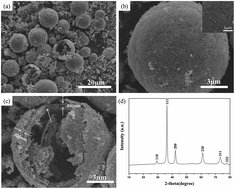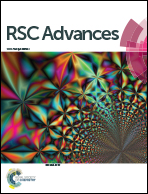Template-free synthesis of complicated double-wall Cu2O hollow spheres with enhanced visible photocatalytic activities
Abstract
In this study, complicated double-wall Cu2O hollow spheres have been successfully prepared by a facile hydrothermal process in a ternary solvent system including water, ethanol and glycerol. The obtained double-wall Cu2O hollow spheres have an average diameter of ∼15 μm and the spheres are assembled by irregular particles with an average diameter of ∼500 nm. Scanning electron microscopy (SEM), X-ray diffraction (XRD) and transmission electron microscopy (TEM) were used to characterize the structure of the synthesized products. The formation mechanism of the double-wall Cu2O hollow spheres is related to a self-assembly process accompanied by an Ostwald ripening process, during which the Cu2O spheres are first formed through the self-assembly of Cu2O nanoparticles and then gradually develop into double-wall hollow interiors by an Ostwald ripening process. Furthermore, the photocatalytic properties of the as-obtained samples were investigated. It is found that such unique double-wall hollow architecture exhibits excellent photocatalytic efficiency for the degradation of MO under visible-light illumination, which is up to 90.3% and this photocatalytic efficiency is higher than the Cu2O particles with irregular spherical structure (74.2%). The high photocatalytic performance of the double-wall Cu2O hollow spheres is associated with the fact that there are plenty of nanopores which exist in the spheres, serving as transport paths for small molecules.


 Please wait while we load your content...
Please wait while we load your content...